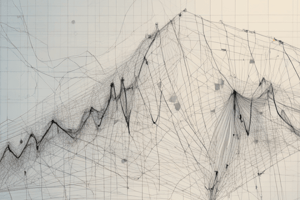Podcast
Questions and Answers
What is the characteristic shape of a quadratic graph?
What is the characteristic shape of a quadratic graph?
- Circle
- U-shaped curve (correct)
- Cubic curve
- Straight line
What is the purpose of a coordinate axis in graphing?
What is the purpose of a coordinate axis in graphing?
- To plot points and draw graphs (correct)
- To construct 2D shapes
- To calculate the intercept of a line
- To measure the slope of a line
What is the formula to calculate the slope of a line?
What is the formula to calculate the slope of a line?
- m = (x2 - x1) / (y2 - y1)
- m = y2 - y1
- m = x2 - x1
- m = (y2 - y1) / (x2 - x1) (correct)
What is the equation of a line in terms of slope and intercept?
What is the equation of a line in terms of slope and intercept?
What is the condition for two lines to be perpendicular?
What is the condition for two lines to be perpendicular?
What is the name of the process of creating 2D shapes using a ruler and compass?
What is the name of the process of creating 2D shapes using a ruler and compass?
What is the common property of 2D shapes?
What is the common property of 2D shapes?
What type of graph shows exponential growth or decay?
What type of graph shows exponential growth or decay?
Flashcards are hidden until you start studying
Study Notes
Types of Graphs
- Linear Graphs: Straight line graphs, where the graph is a straight line.
- Quadratic Graphs: Parabolic graphs, where the graph is a U-shaped curve.
- Cubic Graphs: Graphs with a cubic equation, where the graph has a more complex shape.
- Circle Graphs: Graphs that form a circle, where every point on the graph is equidistant from a central point.
- Exponential Graphs: Graphs that show exponential growth or decay, where the graph has a rapid increase or decrease.
Drawing Graphs
- Coordinate Axes: Graphs are drawn on a pair of coordinate axes, where the x-axis is horizontal and the y-axis is vertical.
- Plotting Points: Graphs are drawn by plotting points on the coordinate axes, where each point has an x-coordinate and a y-coordinate.
- Drawing the Graph: The graph is drawn by joining the points with a line or curve, depending on the type of graph.
Geometry of Straight Lines
- Slope: The slope of a line is a measure of how steep it is, and can be calculated using the formula:
m = (y2 - y1) / (x2 - x1). - Intercept: The intercept of a line is the point where the line crosses the y-axis, and can be calculated using the formula:
y = mx + c. - Equation of a Line: The equation of a line can be written in the form
y = mx + c, wheremis the slope andcis the intercept. - Parallel and Perpendicular Lines: Two lines are parallel if they have the same slope, and two lines are perpendicular if the product of their slopes is -1.
Geometry of 2D Shapes and Construction of Geometric Figures
- Properties of 2D Shapes: 2D shapes have properties such as number of sides, number of vertices, and internal angles.
- Construction of 2D Shapes: 2D shapes can be constructed using a ruler and compass, or using a protractor and straightedge.
- Types of 2D Shapes: Common 2D shapes include triangles, quadrilaterals, polygons, and circles.
- Constructions: Geometric figures can be constructed using a variety of methods, including:
- Bisection: Dividing a line or angle into two equal parts.
- Perpendicular Bisector: Constructing a line perpendicular to a given line, and bisecting it.
- Angle Construction: Constructing a specific angle using a protractor and straightedge.
Types of Graphs
- Linear Graphs are straight line graphs, where the graph is a straight line, with a constant slope.
- Quadratic Graphs are parabolic graphs, where the graph is a U-shaped curve, and the graph opens upward or downward.
- Cubic Graphs are graphs with a cubic equation, where the graph has a more complex shape, and can be increasing or decreasing.
- Circle Graphs are graphs that form a circle, where every point on the graph is equidistant from a central point, called the center of the circle.
- Exponential Graphs are graphs that show exponential growth or decay, where the graph has a rapid increase or decrease, and the rate of change is proportional to the current value.
Drawing Graphs
- Coordinate Axes are a pair of lines that intersect at a right angle, where the x-axis is horizontal and the y-axis is vertical.
- Graphs are drawn by plotting points on the coordinate axes, where each point has an x-coordinate and a y-coordinate.
- The graph is drawn by joining the points with a line or curve, depending on the type of graph, and the graph can be a continuous curve or a series of discrete points.
Geometry of Straight Lines
- The slope of a line is a measure of how steep it is, and can be calculated using the formula:
m = (y2 - y1) / (x2 - x1), wheremis the slope. - The intercept of a line is the point where the line crosses the y-axis, and can be calculated using the formula:
y = mx + c, wherecis the intercept. - The equation of a line can be written in the form
y = mx + c, wheremis the slope andcis the intercept. - Two lines are parallel if they have the same slope, and two lines are perpendicular if the product of their slopes is -1.
Geometry of 2D Shapes and Construction of Geometric Figures
- 2D shapes have properties such as number of sides, number of vertices, and internal angles, which can be used to classify and describe them.
- 2D shapes can be constructed using a ruler and compass, or using a protractor and straightedge.
- Common 2D shapes include triangles, quadrilaterals, polygons, and circles, each with their own unique properties.
- Geometric figures can be constructed using a variety of methods, including:
- Bisection: Dividing a line or angle into two equal parts.
- Perpendicular Bisector: Constructing a line perpendicular to a given line, and bisecting it.
- Angle Construction: Constructing a specific angle using a protractor and straightedge.
Studying That Suits You
Use AI to generate personalized quizzes and flashcards to suit your learning preferences.




